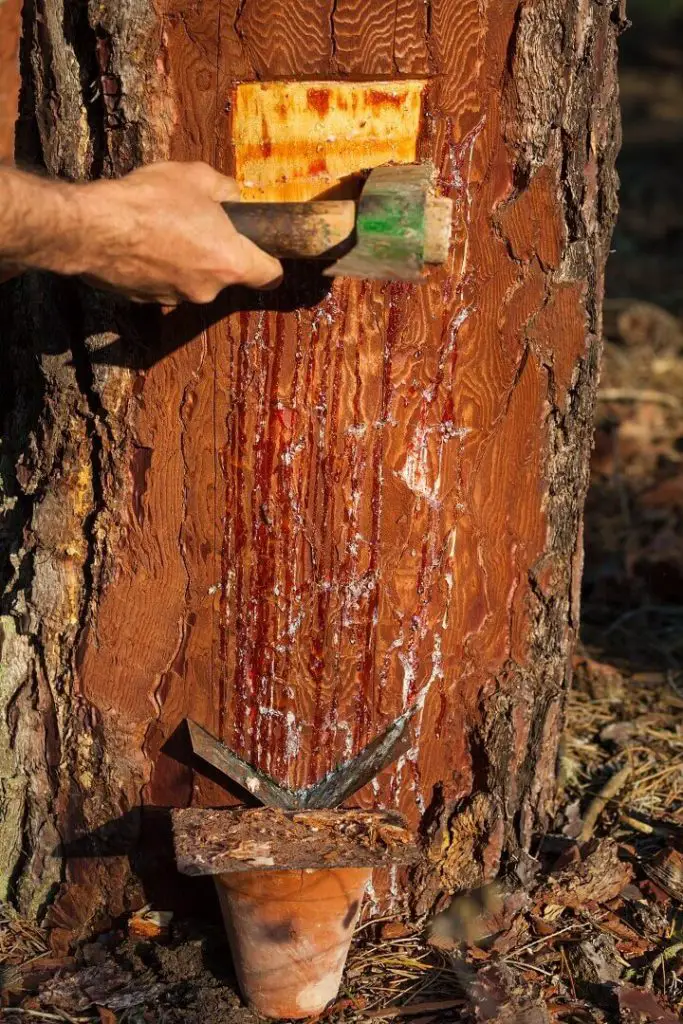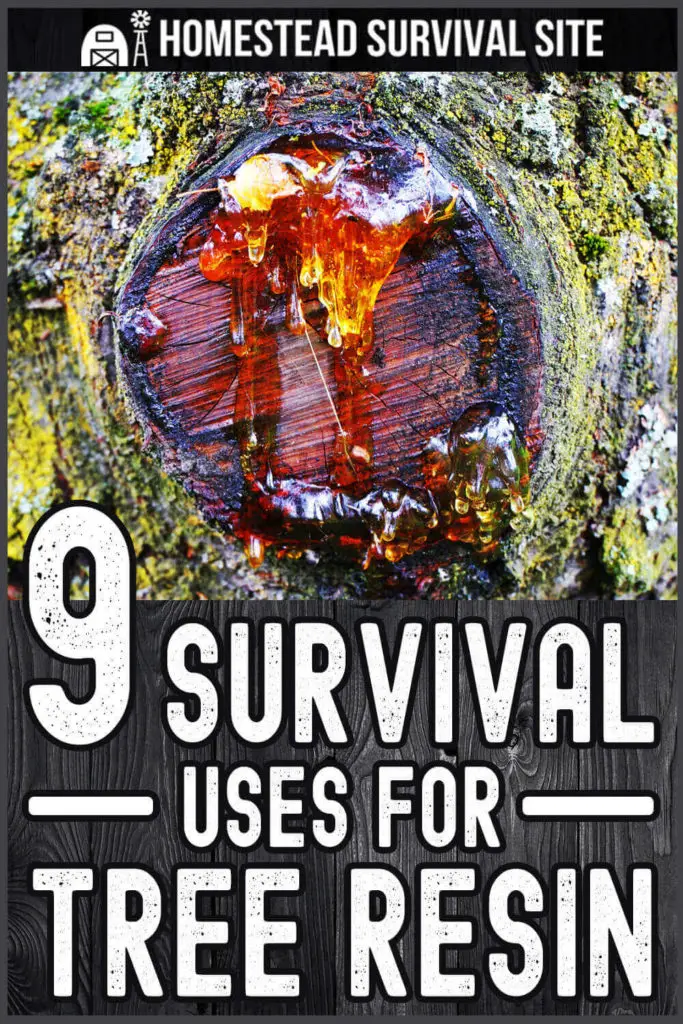Estimated reading time: 8 minutes
A healthy human body is impressive in its ability to heal itself. Your skin can knit itself back together after a minor cut or burn. When correctly set, a broken bone can mend itself. Did you know that many trees have a similar ability?
For example, when a pine tree loses a limb, you will notice that a sticky substance – sometimes called pitch – flows from the tree and covers the open area, essentially covering the wound like a bandage. This substance, called resin, keeps parasites and predators out of the tree and eventually hardens to form a permanent protective seal.
For thousands of years, people all over the world have incorporated the healing powers of tree resin into their medicines and sacred ceremonies. For example, the ancient Egyptians used frankincense and myrrh for spiritual purposes. The ancient Aztecs and Mayans burned copal as part of their sacred rituals. Native Americans burned resins from junipers and pinon pines as part of their meditations and prayer ceremonies.
Native peoples also used resins for a variety of medicinal purposes, especially to promote healing and to prevent infection. These methods have been passed on through the years and can come in handy during an emergency today. This article will explore some of the survival uses for tree resin.
Want to save this post for later? Click Here to Pin It On Pinterest!
What is Tree Sap vs Tree Resin?
Before we get to the uses for tree resin, it is important to make the distinction between tree sap and tree resin. Although many people confuse the two, they are actually different substances.
Most trees produce sap, but only trees that belong to the Pinaceae family – including pine, fir, and cedar trees – produce resin. Another way to look at it is that trees that shed their leaves each year – called deciduous trees – usually have sap but do not produce resin. Coniferous or evergreen trees usually produce both sap and resin.
The liquid that comes from a maple tree is a sap, not a resin. Sap is a thin, clear, watery substance, while resin is thick, amber-colored, and sticky.
Uses for Tree Resin
Now that you know the difference between sap and resin, let's learn about some of the ways you can use resin in a survival situation.
Wound Healing
Resin has antiseptic, anti-bacterial, and anti-inflammatory properties. Just as the sticky substance works to heal a wound in a tree, it also can aid in the healing of human injuries. Here are a few of the advantages of using resin on a wound:
- Protects against bacteria
- Fights inflammation
- Reduces scarring
- Promotes faster healing
Additionally, resin can be applied to slow or stop the bleeding when a minor wound occurs. And it can serve as a temporary bandage after you have cleaned and dried the wound.
You may need to warm the substance first in order for it to adhere to the skin. After heating it, you can apply a thin layer of resin to the affected area. It will act as a barrier, protecting the area from dirt, debris, and moisture.
Waterproof Adhesive
In addition to sealing wounds, resin can serve as a protective sealant in other ways. You can use warmed resin to fill holes in your shoes and boots. When you mix warmed resin with a small amount of powdered charcoal, you can make a strong glue that will help waterproof containers and even boats and canoes.
You can also use heated resin to patch holes in tarps and tents. It will harden as it cools, forming a seal.
For centuries, hunters have used pine resin glue — also called opine pitch glue — to attach points and blades to their shafts and handles. When made correctly, pine pitch glue is strong enough to attach stone, bone, wood, or ivory points and blades to handles or shafts made of bone, antler, or wood.
Here is how to make pine resin glue.
- Melt hardened resin. If the substance ignites, blow out the flame and lower the heat.
- Add one part hardwood charcoal powder to reduce the stickiness of the resin.
- Add one part filler material. This material — which could be ground plant material, sawdust, bone dust, or even animal hair — helps strengthen the glue.
- If you want a flexible glue, add one part beeswax, fat, or tallow to the mixture.
- Mix thoroughly with a stick.
- Apply with a stick.
The hardened glue will resemble glass or crystal in appearance. (If you added beeswax, grease, or fat in the process, it will be more flexible.) The hardened glue is lightweight and easy to carry with you for later use. You can reheat hardened glue to return it to its liquid state.
If you'd prefer to watch the glue-making process, this video shows you how to collect the resin and create a strong glue. Here is another video to check out that shows the steps for making pine pitch glue.
Fire Starter
Tree resin is a highly flammable substance. You can start a fire even in a damp environment by mixing pine resin with tree bark and sticks.
Light Source
You can also use resin along with a strip of cotton, moss, or other organic fiber to mold a candle and a wick. Another option is to place resin on a cloth that you then wrap around a stick for a makeshift torch. This video shows how to make a candle with pine resin.

Pain Reduction
Chewing pine resin as you would a piece of gum can help reduce body aches and pains. Native Americans often mixed the resin with honey and beeswax to make it easier to chew and tastier. You can also steep resin in hot water and sip it as a tea to ease stomach pains and the discomfort of arthritis.
Skin Treatment
You can make salve using tree resin that soothes and helps heal many skin conditions and rashes. Here is a basic recipe for making a tree resin salve.
Ingredients:
- ¼ cup tree resin
- ½ cup olive oil or almond oil
- 1-ounce grated beeswax
Instructions:
- Add the resin to the oil that has been simmering in a double boiler.
- Heat the mixture on low until the resin melts.
- Strain the mixture using a coffee filter or other strainer.
- Return strained mixture to the double boiler and then add the grated beeswax.
- Gently heat the mixture until it is fully melted.
- Pour the mixture into jars or tins and store in a cool, dark place.
Sore Throat Aid
The antiseptic and anti-inflammatory properties of tree resin make it useful for soothing the irritated and swollen tissue associated with a sore throat. It can also ease the coughing related to the common cold.
Make a soothing tea by combining water, pine needles, and resin. Let it steep for about five minutes before straining and drinking. Add honey if you like.
Soap
In a survival situation, you may need to sanitize objects, cleanse wounds, and wash clothing. You can use pine resin to make an effective cleanser. This video shows the steps for making pine tar soap.
Gripping and Friction
Violinists, cellists, and bassists use resin in the form of “rosin” as a way to add friction to their bows and enhance the sound quality of their instruments. Rosin also is used by baseball players and bowlers to help them better grip bats and balls. Ballet dancers sometimes apply crushed resin to their shoes to increase their grip on the floor.
Rosin used for string instruments is made by heating fresh resin until it solidifies. This video allows you to hear the difference between a violin played with rosin on the bow and without.
In a survival situation, you may be able to use tree resin to add friction to your shoes or boots on slippery surfaces.
How to Harvest Tree Resin
To locate fresh tree resin, look for pine trees that have damaged or fallen limbs. Trees often produce an abundant supply of resin, so you'll see an excess amount dripping down the tree. Harvest these drips or take resin from above or below the wound rather than from the wounded area itself. Only take as much as you need so that the tree can continue to protect itself from insects and other invaders.
You can harvest resin any time of the year, and you can collect it in its fresh or dried form. Using a small knife – a butter knife works well – gently scrape the resin into small glass jars or plastic bags or cups. (You are likely to have trouble getting this knife completely resin-free again, so it's a good idea to designate a specific knife for this purpose.)
Some trees will drip resin onto the ground, which you can then scrape off of the tree roots or fallen pine needles. You might even find crystallized chunks of resin beneath a tree. These are a find, so feel free to pick them up and use them.
This video shows you how to find and collect resin in the forest. Depending on the condition of the resin you find, you may want to purify it by heating it before use. Just be very careful when heating and handling hot resin, as it is very flammable.
Like this post? Don't Forget to Pin It On Pinterest!












